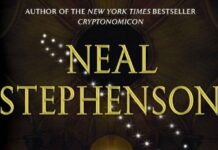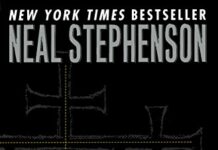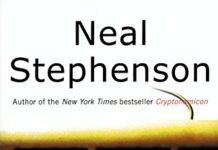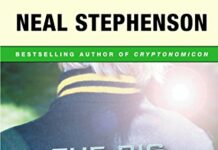
Ebook Info
- Published: 2005
- Number of pages: 640 pages
- Format: Epub
- File Size: 0.78 MB
- Authors: Neal Stephenson
Description
From his triumphant debut with Snow Crash to the stunning success of his latest novel, Quicksilver, Neal Stephenson has quickly become the voice of a generation. In this now-classic thriller, he and fellow author J. Frederick George tell a shocking tale with an all-too plausible premise.
From his triumphant debut with Snow Crash to the stunning success of his latest novel, Quicksilver, Neal Stephenson has quickly become the voice of a generation. In this now-classic thriller, he and fellow author J. Frederick George tell a shocking tale with an all-too plausible premise.
There’s no way William A. Cozzano can lose the upcoming presidential election. He’s a likable midwestern governor with one insidious advantage—an advantage provided by a shadowy group of backers. A biochip implanted in his head hardwires him to a computerized polling system. The mood of the electorate is channeled directly into his brain. Forget issues. Forget policy. Cozzano is more than the perfect candidate. He’s a special effect.
“Complex, entertaining, frequently funny.”—Publishers Weekly
“Qualifies as the sleeper of the year, the rare kind of science-fiction thriller that evokes genuine laughter while simultaneously keeping the level of suspense cranked to the max.”— San Diego Union-Tribune
“A Manchurian Candidate for the computer age.” —Seattle Weekly
User’s Reviews
Neal Stephenson is the author of The System Of The World, The Confusion, Quicksilver, Cryptonomicon, The Diamond Age, Snow Crash, and other books and articles.J. Frederick George is a historian and writer living in Paris. –This text refers to the paperback edition. Excerpt. © Reprinted by permission. All rights reserved. oneWILLIAM ANTHONY Cozzano’s office was a scandal. So it was whispered in the high councils of the Illinois Historical Society. For over a century, under dozens of governors, it had looked the same. Then Cozzano had come along and moved all the antique furniture into storage (Abraham Lincoln was the greatest man in history, Cozzano said, but his desk was a piece of junk, and Stephen Douglas’s side chair was no prize either). Cozzano had dared to move electronics into the frescoed vault of the governor’s office–a thirty-six-inch Trinitron with picture-in-picture so that he could watch C-SPAN and football at the same time! And his chair was no antique, but a high-tech thing with as many adjustable features as the human body had bones. He had suffered enough abuse, he claimed, in Vietnam and on the frozen turf of Soldier Field and didn’t deserve to be mangled by some antique chair day in and day out, Illinois Historical Society be damned. That chair was everything Cozzano wasn’t: fat with padding and glossy with petal-soft leather where Cozzano was lean and craggy and weathered, a man who had waited his whole life to look the way he did now, as if carved from a block of white oak with a few quick strokes of an adze.Cozzano was sitting in the chair one night in January, holding a fountain pen as big as an uncooked hot dog in his left hand. Cozzano returned to his home in the small town of Tuscola every weekend to mow the lawn, rake leaves, or shovel snow, so calluses made a dry rasping sound as his writing hand slid across the paper.The fountain pen looked expensive and had been given to him by someone terribly important a long time ago; Cozzano had forgotten whom. His late wife, Christina, used to keep track of who had given him what and send out little notes, Christmas cards, and so on, but since her death, all of these social niceties had gone straight to hell, and most people forgave him for it. Cozzano found that the pen’s bulk fit his hand nicely, his fingers wrapped around the barrel without having to pinch it like a cheap ballpoint, and the ink flowed effortlessly onto the paper, nib scrawling and calluses rasping, as he signed the endless stream of bills, proclamations, resolutions, letters, and commendations that flowed across his desk like blood cells streaming in single file through the capillaries of the lung–the stately procession that sustained the life of the body politic.His office was on the second floor of the east wing, directly above the capitol’s main entrance, overlooking a broad lawn decorated with a statue of Lincoln delivering his farewell address to Springfield. The room had only two windows–tall narrow north-facing ones that were blocked even from the late afternoon sun by the north wing and the soaring capitol dome. Cozzano called it the “arctic circle”–the only part of Illinois that was in darkness for six months out of the year. This was a somewhat obscure and technical joke, especially in these days of endemic geographic ignorance, but people laughed at it anyway because he was the Governor. He kept his desk lamp going all day, but as the sky had darkened and as he worked into the night, he had not bothered to turn on the overhead fixtures, and he now sat in a pool of illumination in the middle of the dark office. Around the edges of the room, innumerable pieces of decoration reflected the light back at him.Each governor decorated the office in his own way. Only a few things were immutable: the preposterous fresco on the ceiling, the massive doors with brass lions’ heads mounted in their centers. His predecessor had gone in for a spare, classical nineteenth-century look, filling the place up with antiques that had belonged to Lincoln and Douglas. This impressed visitors and looked nice for the tour groups who came by every hour to launch flashcube barrages over the velvet rope. Cozzano had banned the tour groups, slamming the doors in their faces so that all they could see was the brass lions, and turned the office into a cluttered Cozzano family museum.It had started on the day of his first inauguration, with a small photo of his late wife, Christina, placed on the corner of his historically inaccurate desk. Naturally, photos of his children, Mary Catherine and James, came next. But there was no point in stopping with the immediate family, and so Cozzano had brought in several boxes containing pictures of patriarchs and matriarchs going back several generations. He wanted pictures of his friends, too, and of their families, and he also needed various pieces of memorabilia, some of which were chosen for sentimental reasons, some for purely political ones. By the time Cozzano was finished decorating his office, it was almost filled with clutter, smelling salts had to be brought in for the Historical Society, and, as he sat down for the first time in his big leather chair, he could trace the entire genealogy and economic development of the Cozzano clan, and of twentieth-century Illinois, which amounted to the same thing.There was an old aerial photograph of Tuscola as seen from its own water tower in the 1930s. It was a town of a few thousand people, about half an hour south of the academic metropolis of Champaign-Urbana and a couple of hours south of Chicago. Even in this photo it was possible to see gaudy vaults in the town cemetery, and Duesenbergs cruising the streets. Tuscola was, for a farm town, bizarrely prosperous.In an oval frame of black walnut was a hand-tinted photograph of his great-grandfather and namesake Guillermo Cozzano, who had come to Illinois from Genoa in 1879. In typically contrary Cozzano fashion he had bypassed the large Italian communities on the East Coast and found work in a coal mine about thirty miles southwest of Tuscola, where soil and coal were the same color. He and his son Giuseppe had gone into the farming business, snapping up one of the last available parcels of high-quality land. In 1912, Giuseppe and his wife had their first child, Giovanni (John) Cozzano, followed three and five years later by Thomas and Peter. All of these events were recorded in photographs, which Cozzano would be more than happy to explain to visitors if they made the mistake of expressing curiosity, or even allowing their eyes to stray in that direction. Most of the photos featured buildings, babies, or weddings.John Cozzano (photo) lost his mother to influenza at the age of six and, from that point onward, lived his life as if he had been shot from a cannon. During his high-school years in the vigorous 1920s he held down a part-time job at the local grain elevator (photo). By the time economic disaster struck in the 1930s he had worked his way up into the management of that business. With one foot in his father’s farm and the other in the grain elevator, John was able to get the family through the Depression in one piece.In 1933, John fell in love with Francesca Domenici, a young Chicago woman. As evidence of his fitness to be a husband, he decided to buy an enormous stucco Craftsman house on a tree-lined brick street on the edge of Tuscola (photo). Even by the standards of Tuscola, which had an inordinate number of large and magnificent houses, it was a beaut: three stories, six bedrooms, with a full basement and a garage the size of a barn. All of the woodwork was black walnut, thick as railroad ties. He was going to buy the place for five hundred dollars from a railway company man who had gone bankrupt. At this time, John had only three hundred dollars in the bank, and so he was forced to borrow the remaining two hundred.This quest eventually led him to Chicago, and to the doorstep of Sam Meyer (photo), formerly Shmuel Meierowitz. Sam Meyer operated a number of coexisting businesses out of a single storefront on Maxwell Street, on Chicago’s near west side (photo). One thing he did was lend money. Sam’s son was named David; he was a lawyer.Every Italian person John Cozzano had ever spoken to for more than about ten minutes had spontaneously warned him of the danger of borrowing money from Jews. He had accepted these warnings at face value until he overheard Anglo-Saxons in Tuscola warning each other, in exactly the same terms, of the dangers of borrowing money from Italians. John borrowed the money and bought the house. As soon as he had cleaned all the junk out of the basement and taken care of a dire flea infestation, he went back up to Chicago and proposed to Francesca.He bought a ring from Sam Meyer on credit and they were married in Chicago in June 1934. After a short honeymoon at the Grand Hotel on Mackinac Island (photo), they moved into the big house in Tuscola. Within eleven months, John had repaid all of his debts to Sam Meyer, and he discovered that, contrary to legend, it was possible to carry on a financial transaction with a Jew without forfeiting your shirt, or your immortal soul.This planted a seed in his mind; he might be able to buy the grain elevator on credit and get rid of the feeble old man and the incompetent drunk whom he had been working for. John spent the rest of the 1930s buying the elevator and then trying to develop it into something bigger: a factory to convert corn into other things. Francesca spent the same time trying to get pregnant. She had four miscarriages but kept trying anyway.As of the beginning of 1942, when America entered the war, John Cozzano, Mr. Domenici, Sam Meyer, and David Meyer were partners in Corn Belt Agricultural Processors (CBAP), a successful corn syrup production facility in Tuscola, Illinois (photo). John and Francesca were the parents of a brand-new baby boy, William A. Cozzano (photo), who by that time was the fourth grandchild of Giuseppe. He was, however, the first grandson. Everyone who laid eyes on the new baby predicted that he would one day be President of the United States.Thomas joined the army, was sent in the direction of North Africa, but never got there; his transport ship was sunk by U-boats in the North Atlantic. Peter found gainful employment as a Marine sniper in the Pacific. In 1943 he was taken prisoner by the Japanese and spent the rest of the war starving in a camp. John was both too old and, as a farmer, too strategically important to be sent off to war. He stayed home and tried to keep the family enterprises afloat.War required lots of parachutes. Parachutes took a hell of a lot of nylon. One of the feedstocks required to manufacture nylon was cellulose. One excellent source of cellulose happened to be corncobs. And John Cozzano’s factory had been throwing away corncobs by the hundreds of tons ever since it had gone into production. The heap of corncobs that rose from the prairie outside of Tuscola had now become the highest point in several counties and could be seen from twenty miles away, especially whenever pranksters set fire to it (photo).Sam Meyer contacted everyone he knew. A lot of these were recent immigrants from Central Europe and were only too happy to invest in a parachute factory, knowing that it could have only one conceivable practical use. John got the nylon production unit up and running just in time to throw out a very low bid on a very large government contract. The next year, Allied shock troops poured into Normandy borne on billowing canopies of Cozzano nylon (photo).Peter came back from war with bad kidneys and a bad leg. While he was not well equipped for doing physical labor, he performed a useful role as troubleshooter, figurehead, and conversationalist for CBAP until he died of kidney failure in 1955. His father, Giuseppe, died two months later. During the interval between the war and these deaths, things had gone smoothly for the Cozzano family, except for the annihilation of the ancestral farmhouse in 1953 by a tornado (photo).Two times in two months, the entire Meyer clan, led by Samuel and David, came down from Chicago to attend funeral services. Hotel rooms were scarce in Tuscola and kosher kitchens nonexistent, so John and Francesca put the Meyers up in their big stucco house and did what they could to provide them with acceptable cooking facilities. Francesca learned to keep a blowtorch handy so that Sam Meyer’s son-in-law, a rabbi, could perform a ritual cleansing of her oven (photo).During these visits, William Cozzano, now thirteen, shared his bedroom with a number of younger Meyers, including David’s son Mel, who was the same age. They became friends and spent most of the time down the street at Tuscola City Park playing baseball, Jews versus Italians (autographed baseball in glass box).A year later Samuel Meyer died in Chicago. The Cozzanos all came north. Some of them stayed with the Domenicis, but the Meyers returned the favor by giving other Cozzanos a place to stay. Mel and William shared a mattress on the floor (photo).After that, Mel and William stayed in constant touch. They liked each other. But they also knew they were the eldest sons of families that had accumulated much and that if they screwed up and lost it, it would be no one’s fault but their own.The remaining space in the office was filled with William A. Cozzano’s personal memorabilia:A black-and-white photo of his parents, the Olan Mills logo slanted across the bottom, shot in a makeshift traveling studio in a Best Western motel on the outskirts of Champaign-Urbana in 1948.An assortment of six-inch-high capital letter T’s, made from cloth, mounted under glass, along with a corny photo of the seventeen-year-old Cozzano, pigskin tucked under one arm, other arm held out like a jouster’s lance to straight-arm an imaginary linebacker from Arcola or Rantoul.Diploma from Tuscola High.A photo of William with Christina, his high-school sweetheart, on the campus of the University of Illinois, where they had both attended college in the early sixties.A wedding picture, the couple flanked by eight rouged and false-eyelashed sorority belles on one side and seven tuxed and pomaded University of Illinois football players, plus a single Nigerian graduate student, on the other.Diploma (summa cum laude) with major in business and minor in Romance languages.A battered and abraded football covered with thick stout signatures, marked ROSE BOWL.Two photos of Cozzano in the Marines, mounted side by side in the same frame: one, picture-perfect William in full-dress uniform, staring into the distance as though he can see a tunnel of light in the sky at one o’clock high, JFK in glory at the end of the tunnel, asking William what he can do for his country. The second picture, two years later: William Cozzano in a village in the Central Highlands, unshaven, eyes staring out alarmingly white and clean from a smoky face, a slack-jawed, inadvertent grin, a Browning automatic rifle dangling from one hand, a cherubic Vietnamese girl sitting in the crook of the other arm with her left leg wrapped in fresh white gauze, staring up at him with her tiny mouth open in astonishment; Cozzano was smiling through a crazy weariness that threatened to bring him to his knees at the next moment but the girl sensed that she was safe there. –This text refers to the paperback edition. From the Back Cover From his triumphant debut with “Snow Crash to the stunning success of his latest novel, “Quicksilver, Neal Stephenson has quickly become the voice of a generation. In this now-classic thriller, he and fellow author J. Frederick George tell a shocking tale with an all-too plausible premise. There’s no way William A. Cozzano can lose the upcoming presidential election. He’s a likable midwestern governor with one insidious advantage–an advantage provided by a shadowy group of backers. A biochip implanted in his head hardwires him to a computerized polling system. The mood of the electorate is channeled directly into his brain. Forget issues. Forget policy. Cozzano is more than the perfect candidate. He’s a special effect. “Complex, entertaining, frequently funny.””–Publishers Weekly “Qualifies as the sleeper of the year, the rare kind of science-fiction thriller that evokes genuine laughter while simultaneously keeping the level of suspense cranked to the max.””– San Diego Union-Tribune”A “Manchurian Candidate for the computer age.” “–Seattle Weekly ” –This text refers to the paperback edition. Review “A Manchurian Candidate for the computer age” * Seattle Weekly * –This text refers to an alternate kindle_edition edition. From the Inside Flap From his triumphant debut with “Snow Crash to the stunning success of his latest novel, “Quicksilver, Neal Stephenson has quickly become the voice of a generation. In this now-classic thriller, he and fellow author J. Frederick George tell a shocking tale with an all-too plausible premise. There’s no way William A. Cozzano can lose the upcoming presidential election. He’s a likable midwestern governor with one insidious advantage–an advantage provided by a shadowy group of backers. A biochip implanted in his head hardwires him to a computerized polling system. The mood of the electorate is channeled directly into his brain. Forget issues. Forget policy. Cozzano is more than the perfect candidate. He’s a special effect. “Complex, entertaining, frequently funny.””–Publishers Weekly “Qualifies as the sleeper of the year, the rare kind of science-fiction thriller that evokes genuine laughter while simultaneously keeping the level of suspense cranked to the max.””– San Diego Union-Tribune”A “Manchurian Candidate for the computer age.” “–Seattle Weekly ” –This text refers to an alternate kindle_edition edition. Read more
Reviews from Amazon users, collected at the time the book is getting published on UniedVRG. It can be related to shiping or paper quality instead of the book content:
⭐ Huh… Bit of a time warp reading this book…Bearing in mind this book came out just before the internet took off, laptops were still quite hefty devices with hard drives in the megabytes not terrabytes, and a cell phone was a flip case gimmick with painful 12 key texting and… well, really, with this book set in the near future of the 1990s, it is actually surprisingly readable!Fortunately, the premise of the book is not about our modern day world with computers, hacking etc. This is a book set about technology being used to satisfy the demands of the elite few- something we are probably even more familiar with in 21-teens than we were in the 1990s! And once you get through the first 15% or so of the book where you are puzzling over how a book written in 2005 can not have smartphones and internet, the story moves away from having to rely on that kind of technology to more familiar tech that people wish worked today..I don’t want to give away too much of the plot – its described in enough enticing detail if you are contemplating buying this book. Suffice to say, like most Neal Stephenson books, this is a highly satisfying read, unputdownable and its going to keep you turning the pages into the wee hours of the morning. Not sure what J. Fredrick George did for this book – provided some of the history that pops up in a non-distracting way? The story line? Not sure – it reads like a Neal Stephenson novel, but more like Reamde or D.O.D.O. which I found to be really good stories from start to finish.However, I do wish when the publishers ‘reprint’ books, it is clear when the book is first published – especially for for science fiction! It is highly confusing to read a book that seems to be set in the 1990s when its “publication” date is the 21st Century!
⭐ From the moment Orwell wrote his “1984” in 1949, it took quite a few decades, until we all realized it was no longer fiction. For “Interface”, which Neal Stephenson wrote in 1994, this “bingo” moment is now. Change the fictional names and dated technologies to the ones from today’s headlines – and that’s it. All you wanted to know about the uncanny marriage of politics, money, biotechnologies and data science, is there. With all the potential to be a political blockbuster, the book for some strange reason is not as known as many other of his works, there was no even attempt to make a movie based on it, and the list of languages into which it was translated is surprisingly short. Could it be because Neal Stephenson was able to foresee more than expected and it is happening right now?
⭐ As improbable as it looks like, reading about the American electoral process to choosing the next President was anything but boring. On the contrary, as the reader advances through the pages, the story unfolds into a riveting thriller, a page turner that will take the less disciplined among the readers into the wee hours of morning as they seek to reach the outcome of the story which, by the way, reserves a never ending stream of unexpected surprises, the one more mind blowing than the previous, a most gratifying and enjoyable experience indeed if fun reading is your goal.
⭐ Brilliant book by a marvelous pair of writers. Complex, but not too hard to follow, entertaining characters whose lives you care about, pacing that is sometimes slowly lingers over poignant moments, sometimes races ahead like the best of thrillers, brilliant insights into the businesses behind politics and the nature of human beings, a delicious science-fiction conspiracy plot, a deranged killer, wonderfully realistic characters, a man struggling with a huge disability, and one of those stories were every odd disparate puzzle piece dropped down for your consideration fits neatly in the end to provide the entire picture. I haven’t been this entertained by a novel in a long time.
⭐ As a huge afficionado of Neal Stephenson, and after enjoying Cobweb, another novel by Stephenson and George that has held up well in the past 25 years, I was sadly disappointed by Interface. I’m sure it was an enjoyable novel in its time, however, unfortunately it does not hold up well 20 years after the setting of the novel. Too much has changed in politics, society, and technology to enable suspension of disbelief for this book.
⭐ While this had the usual hallmarks of Stephenson’s writing, including lots of insightful humor, it appears to be still a work in progress, as it didn’t hang together. Loose ends never were tied up. Ending was a mishmash. I’ve read all of his books and overall this was the least satisfying.
⭐ The book was a fun fast pace read. As a early book written in the preinternet it is not a work I would have expected from Stephenson. But the politics are creepy as they are today.
⭐ The real meat of the story doesn’t hit until nearly two thirds of the way in. After this, the momentum builds steadily to the final everything-hitting-the-fan chapters. It you have the patience, it is an entertaining ride.
⭐ …was Richard Condon. And he was ~very~ good! He wrote novels that had nearly impossibly complex plots become hysterically funny. One of those novels posited what many of us have long believed: that Prohibition was merely a plot by Joe Kennedy to increase the street price of liquor, and that he was able to pull it off by persuading Congress to enact the legislation. When it became so painfully obvious that Prohibition was more of an evil than not, it got repealed, but not before old Joe had made enough money to get at least one son into the White House, with others to (hopefully) follow. That novel was Mile High .And then along came Michael Crichton, and from time to time he, too, was good, but only rarely very good. Had Crichton bothered to talk with Condon before writing The Terminal Man , he might have written Interface. I think that, at some time in Stephenson’s life, he had a Condon biochip implanted, and that chip has enabled him to continue to RC’s reincarnation.Bottom line is that Stephenson writes dense, convoluted, hilarious prose that seems to be able to interweave itself with my neurons. Condon was for many years my favorite author. I’m confident that he would be flattered to share that distinction with Stephenson. I have to wonder whether he met Condon. Hopefully Stephenson will write another novel or three.
⭐ Interface is techno thriller that manages to bring together diverse characters, locales and an intricate plot into a fairly believable near future scenario in which the soon to be President of the United States is controlled by a computer chip implanted in his brain after a stroke.It’s full of interesting characters including the first black female President of the United States of America, who begins the story as a nearly homeless bag lady plagued by misfortune. Then there is Floyd Wayne Vishniak, participant in polling research and destined to become a serial killer whom no one believes as he hunts down the conspirators controlling the candidate he has been watching on TV, whom he is certain is being mind controlled. Cy Ogle is the manipulative pollster at the center of the plot to put a puppet into the White House. These are just a few of the lively, interesting characters you’ll encounter.One of the things that I enjoy most about Stephenson’s writing is his ability to put me inside the head of each character as they progress through their various pieces of the overall plot. Interface is one of many novels by Mr. Stephenson that kept me interested from the moment I picked it up until the moment I’d digested the last word. Could the events described in the book happen? Certainly.Most of us believe that our government is doing things behind our back all the time. Are there really secret societies trying to pull strings behind the scenes and outside the law. Absolutely. Are they as powerful and effective as the ones described in Interface. Who knows? I’m not a member of a secret society. And if I was I wouldn’t be allowed to talk about it. If I did talk about it, I’d have to kill you afterwards.The truth is, the government doesn’t even know what the government is doing more than half of the time. In such an environment there are always rogue operators both inside and outside officially approved uses of power. Some of them are caught, and some of them are not. Certain types of human beings will always look out for their own interests above all else and at the expense of others.Interface is an enjoyable novel about people looking out for their own perceived interests. It’s got medical aspects, psychological aspects, technological aspects and most of all, characters that pull you into the story and keep you interested in what happens next.
Keywords
Free Download Interface: A Novel in Epub format
Interface: A Novel Epub Free Download
Download Interface: A Novel 2005 Epub Free
Interface: A Novel 2005 Epub Free Download
Download Interface: A Novel Epub
Free Download Ebook Interface: A Novel




